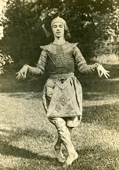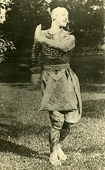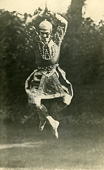Nijinsky – “God of Dance”
An interactive illustrated experience for the iPhone/iPad & Android devices
Designed for those who love dance



Schéhérazade, Auguste Bert, Paris 1910
This unique eBook/App presents 242 photographs of the legendary ballet dancer and star of the Ballets Russes
Discover Nijinsky in 21 ballets from 1906 to 1916 together with images of him in civil life from 1902 to 1928
"One of the most remarkable collections in the world"
Dance Magazine, June 1950
View video introduction to the App:
Danse Siamoise, selections from a series of 19 photographs by Eugène Druet, Paris 1910 "Nijinsky´s dance was music made visible." This eBook/App offers two identical sets of photographs for a varied and interactive experience. One set is divided between the sections Ballets, Student Life, and Civil Life, with supporting information on the majority of photographs. In the second set, located in the Photo Album, they are thumbnails that allow for zooming and swiping. Considering the large number of photographs in the collection, this section facilitates immediate access to all the images, thus providing viewers, especially dancers, the possibility to quickly skip between photos to compare poses, gestures, expressions, and costumes. The Photo Album is presented without supporting information to offer a more contemplative experience without textual diversion. With this eBook/App, viewers have access to the Roger Pryor Dodge Collection at their fingertips, accompanied by two of his articles. Additionally, the seminal article by Edwin Denby and a meditation by Daniel Gesmer, both inspired by this collection, offer illuminating observations to provide a more profound viewing experience. A tribute by Tamara Karsavina, one of Nijinsky´s principal dance partners, offers a personal expression of his artistry. Coupled with several ballets, evocative commentary by writer and photographer Carl Van Vechten, and by Cyril W. Beaumont, a dance writer, publisher and bookseller, who attended every season of the Ballets Russes in London from 1912 to their final performance in 1929, offers a first hand impression of Nijinsky´s brilliance. These remarkable photographs of Vaslav Nijinsky are from the collection of Roger Pryor Dodge (1898–1974). He was fortunate to have seen Nijinsky dance in Tyl Eulenspiegel when the Ballets Russes performed in New York in 1916. Already active as a social dancer, Dodge´s first exposure to ballet proved to be a momentous experience, so inspiring that he began taking classes in ballet. In 1920 at age 22, he moved to Paris to continue his training with Nikolai Legat, one of Nijinsky´s teachers, Lubov Egorova, who had partnered with Nijinsky with the Ballets Russes, and Léo Staats, the maître de ballet at the Paris Opera. Nijinsky´s career had ended prematurely due to the onset of schizophrenia; his last performance took place in 1919 at the age of 30 in front of an invited audience in St. Moritz, Switzerland. Realizing that photography was the only available means to experience Nijinsky´s greatness as no films of him dancing were ever produced, my father had the foresight to preserve a photographic record of that era´s greatest dancer. He proceeded to purchase prints from the photographers who had taken studio portraits of Nijinsky in his various roles, sometimes even skipping meals to afford them. Additionally, this pursuit took him to newspaper offices so that he could acquire every available image. His years of collecting resulted in the most comprehensive collection of photographic images of Vaslav Nijinsky. Upon returning to New York in 1921, my father entered the Metropolitan Opera corps de ballet, an engagement he held for six seasons while continuing his ballet training with Mikhail Fokine, the creator of several ballets featuring Nijinsky. In 1925 he took a leave of absence from the Metropolitan Opera to join the company of another member of the Ballets Russes, Adolph Bolm, when Bolm brought his troupe to Argentina to perform Le Coq D´Or at the Teatro Colón, where Nijinsky had performed. A small selection from my father´s collection was first published when loaned to Romola Nijinsky for her book, Nijinsky, published in 1934. Lincoln Kirstein, who collaborated on this book, later wrote that "Roger Dodge´s close observation of Fokine´s early ballets and Nijinsky´s performance and choreography kindled my own attempts to study theatrical movement."1 In 1937, with the desire that a new generation share his enthusiasm and be inspired by Nijinsky, and realizing that keeping these photographs to himself for his own private enjoyment would be of little service to Nijinsky´s memory, my father made his collection available to the public by donating it to the Dance Collection at the New York Public Library (currently the Library for the Performing Arts at Lincoln Center). Later, during the 1950s–60s, seeking a broader exposure for the photos, my father approached editors to propose a major illustrated book. His design concept resembled a photographic portfolio, with one image per page and the facing page left blank, to insure that viewers would indulge in the beauty of the images without textual distraction. He was unable to interest publishers as he would not compromise on the format he believed these photographs required to achieve the greatest effect. His expectations were too high and the specifications too costly. Besides, ballet, and dance in general, had not yet developed a sufficiently dedicated public and market to warrant a major illustrated book, let alone one of such extravagance. In 1975, two years after my father´s death, the widely acclaimed illustrated book Nijinsky Dancing eventually unveiled a large selection of his collection to a wider audience. The book was the brainchild of Lincoln Kirstein who wrote the text. A balletomane par excellence, Kirstein was an early supporter of George Balanchine; together they founded the New York City Ballet in 1948.
"Druet´s series must rank as one of the first and most complete documents of staged movement" Lincoln Kirstein






Tamara Karsavina, May 1950
______________________
1Kirstein, Lincoln, Nijinsky Dancing, New York, Alfred A. Knopf, 1975, p. 13.